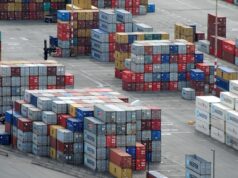The global implementation rate of measures on trade facilitation and paperless trade is picking up, although challenges persist, according to a new report launched November 1 by the United Nations Economic and Social Commission for Asia and the Pacific (ESCAP), together with all four other UN regional commissions for Africa, Europe, Latin America and Caribbean, and West Asia.
The second UN Global Survey on Trade Facilitation and Paperless Trade Implementation covers 120 countries and 47 measures related to the WTO’s Trade Facilitation Agreement (TFA), paperless trade, and inclusive development.
Global average
Results of the survey conducted between January and July 2017 show that the global average implementation rate of the set of 31 common trade facilitation and paperless trade measures considered in this report is about 60%.
Developed economies have the highest implementation rate (78.5%), while Pacific Islands have the lowest (28.2%). Among the developing regions, Latin America and the Caribbean and Southeast and East Asia achieve high implementation rates at 67.8% and 62.7%, respectively.
In contrast, Sub-Saharan Africa—which includes some of the poorest countries in the world—and South and East Europe, Caucasus and Central Asia—a region largely made up of landlocked developing countries—achieve implementation rates of 51.8% and 50.7%, respectively.
The Netherlands (93.6%) stands out as the best overall performer. In developing regions, Singapore, South Korea, China, Malaysia, and Thailand are the top performers in Southeast and East Asia, all with implementation rates exceeding 80%. Qatar and United Arab Emirates lead the Middle East and North Africa region, both with implementation rates exceeding 90%.
Benin (79.6%) is the top performer in Sub-Saharan Africa, while India (72.0%) leads the way in South Asia. The Former Yugoslav Republic of Macedonia (81.7%) leads the South and East Europe, Caucasus and Central Asia region4. Mexico, Colombia, Brazil, Chile and the Dominican Republic are the top performers in Latin America and the Caribbean, all with implementation rates exceeding 80%.
Being a small or less developed country is not necessarily associated with a low implementation rate. For instance, more than 40 economies with GDP per capita of less than $10,000 achieve implementation rates higher than 50%.
Least developed countries, landlocked developing countries, and small island developing states achieve average implementation rates between 40% and 50%, significantly below the global average implementation rate, indicating that these countries may need further technical assistance and capacity building support to help them bridge the existing implementation gap.
Paperless trade
The global average implementation rate of “paperless trade” measures stands close to 50%. Measures such as “electronic/automated customs systems,” “Internet connections fully available to customs and other trade control agencies,” and “electronic submission of customs declarations” have been either fully or partially implemented in most countries surveyed.
However, implementation of more advanced paperless trade measures remains at a relatively early stage. For example, while nearly 60% of the economies have engaged to some extent in creating an electronic single window for processing trade documents, very few have fully operational systems in place.
The global average implementation level of “cross-border paperless trade” is 33%, substantially lower than that of the other groups of measures considered. While the average implementation level of “laws and regulations for electronic transactions” exceeds 60%, steps to enable the cross-border electronic exchange and recognition of regulatory documents, such as certificates of origin and sanitary and phytosanitary certificates, have been taken in less than 30% of the economies considered in this report.
Trade facilitation
The report also examined the progress in implementing trade facilitation measures made by the 99 countries covered in both the 2015 and 2017 global surveys.
Considering all 99 countries, the overall implementation rate increased by about 9 percentage points between 2015 and 2017 (from 50.8% to 59.8%). Sub-Saharan Africa made the most progress, raising its average implementation rate by 17.2 percentage points (from 38.0% in 2015 to 55.2% in 2017). Noticeable progress was also observed in other regions including South Asia (7.4 percentage points), Southeast and East Asia (4.8 percentage points), and the Pacific Islands (3.4 percentage points).
Implementation of the “transparency” measures increased from 66.8% in 2015 to 75.7% in 2017 while implementation of the “formalities” measures improved from 60.1% to 69.4%. Substantial progress was observed in implementing “institutional arrangements and cooperation” measures: the implementation rate rose from 50.5% in 2015 to 62.6% in 2017. Implementation of paperless and cross-border paperless measures improved by 7.8 percentage points (from 50.8% to 58.6%) and 9.3 percentage points (from 25.0% to34.3%), respectively.
The report concluded that “across all surveyed countries there is strong momentum towards the implementation of trade facilitation and paperless trade measures, a result favored by the recent entry into force of the TFA.”
“Moving forward, countries should continue to apply modern information and communication technologies and develop paperless trade to simplify trade procedures and enable electronic exchange of data and documents, not only between stakeholders domestically, but with all the actors along the international supply chain,” it added.









